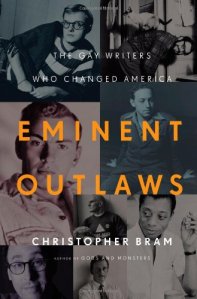
What We’re Reading: Eminent Outlaws: The Gay Writers who Changed America
Christopher Bram
Twelve: hardcover (1st Edition)
372 pages
I tracked down Eminent Outlaws: The Gay Writers who Changed America by Christopher Bram from my local library on a recommendation from a friend and classmate. She thought of Eminent Outlaws after workshop critique and shop talk. Always on the lookout for good queer books, I decided to skip it to the top of my laundry list of “To Read” books. Though I didn’t get to finish it at that time, the book still stuck with me, and had added many other books and articles to my reading list. So when Amazon offered it to me at a clearing-house price and with two-day free shipping, well I couldn’t say “no.”
Despite copping out of writing about both gay and lesbian writers in his introduction (Although in Bram’s defense, he did admit to it, and he is right: Lesbian literature needs its own historian), Eminent Outlaws is a witty, sometimes heartbreaking, sometimes whirlwind wild-ride through the lives of several key gay writers from the late 1940’s to the late 90’s, including characters (and I do mean characters) such as: Gore Vidal, Allen Ginsburg, Tennessee Williams, James Baldwin, Truman Capote, Christopher Isherwood, Edmund White, Armisted Maupin, Larry Kramer, James Merrill, and Andrew Holleran.
The book’s narrative is told mostly in chronological order, divided into decades, then into chapters that tell the stories of these writers, weaving their love lives, their literary lives, and their public lives, and how these lives crossed, sometimes volatilely. My favorite part of Bram’s writing is the way he makes the characters and the scenes of his history come alive: Vidal’s colorful and controversial appearances as a political correspondent, Maupin and Anderson’s exploration of the spirit world with an Ouija board, and Allen Ginsberg’s infamous obscenity trial. A mix of story-telling and fact goes into any good non-fiction book, but Bram does so with not only the craft of a wonderful writer, but with the aim of a conscientious queer writer who wants to show us that we aren’t—and have never been—alone.
Bram concludes the book saying that literature, specifically the literature he talks about, shaped and really began the gay movement. He says, “these novels, plays, and poems spoke first to gay readers, giving them a place to explore and understand their own feelings.” I’m not entirely sure I buy that; literature may have played a part—even a big part—in the beginnings of the (still ongoing) gay movement, but I don’t know that it can take all the credit for starting it. In the epilogue, Bram also discusses the beginning of the new millennium for gays and gay writers. “A few years into the new millennium,” he says, “the book business began to change. Around the time Hollywood decided to concentrate on blockbusters and lost interest in independent movies, publishing lost interest in midlist novels—and gay fiction is nothing if not midlist.” Here, he’s talking about my generation. Circa 2008—when many of the famous gay bookstores Bram mentions during his extended portrait closed—were the years when I would have been looking for this “midlist” gay fiction, and I found it thin on the ground, with road signs to point the way few and far between.
Bram ends on a more positive note though: “one might claim that gay people have won their rights but lost their literature. It has a nice dramatic sound, but I don’t see things so harshly. As I said, good work continues to be produced. However, we are going through a transitional period, in both the medium for storytelling and the kinds of stories people want. We don’t know yet what the next phase will be.” It might be because of the generational gap (I would hate to think a book published in 2012 is already dated), but I don’t quite agree with Bram here either. Not that he isn’t right. He is absolutely right—we are going through a transitional period, but I might argue that we’re already coming out the other side. I see my peers and others doing great work in the form of self-published chapbooks, zines, blogs, YA novels, YouTube channels, and twitters. Perhaps the touchstone authors in Bram’s work were part of a golden age of gay writing (though I would seriously love to see best-sellers on par with The Berlin Stories and The City and The Pillar, with the caveat of maybe less white cis men), but if they were the outlaws, then the new generation of queer writers are guerilla warriors.
((tl;dr: A+ work, recommended reading for anyone, recommended buying for literature, history, and literary history buffs))
A (totally bias) Selection of Works Mentioned:
The City and The Pillar, Gore Vidal
Giovanni’s Room, James Baldwin
The Berlin Stories, Christopher Isherwood
Burr, Gore Vidal
Christopher and His Kind, Christopher Isherwood
Tales of the City, Armisted Maupin
States of Desire, Edmund White
The Night Listener, Armisted Maupin
